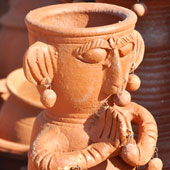Design Resource
Terracotta
Terracotta Production in Chitoor
by
Prof. Bibhudutta Baral,C. Susanth and J. Antony William
The making process involves different stages such as clay refining, clay mixing, throwing on the wheel, drying and firing.
Clay Refining and Mixing
In the Initial stage the clay is refined by removing the dust particles like stones, lumps and other impurities in the clay. This is done manually using fine nets to filter the dry clay. Now the raw materials such as isuka-sand, matti-clay are added with water to prepare the dough. The craftsmen mix the clay by stamping and crushing for the better mixing of clay.
Throwing Process
The throwing process is done on the potter’s wheel. The mixed clay is placed on the center of the wheel. Then the wheel is rotated with the help of bamboo stick. As the wheel starts rotating, the craftsmen start to shape the clay into the required form.Different parts of the object are turned separately and then joined together later. Smoothening of the outer surface is done with wet cloth and the motif patterns are done using sharp edged metal piece.Some objects such as pots, bowls, and vessels are beaten with a flat wooden bat and a mushroom shaped stone which is held inside the object. This process is repeated until the required thinness is achieved. The object is allowed to dry under the sun for 2 to 3 days. The object is also not dried for a longer period as it becomes very tough. Some products are also covered with clothes to avoid excess drying and cracks on the surface of the object.
Firing the Clay objects
The firing is done in the bhatti-traditional open furnace within a circular area. The articles are piled carefully and covered by locally available fuel such as dry coconut leaves, small wooden pieces. The kiln is covered with mud and fired to produce a very high temperature. The objects after firing turn into two different colors such as red and black. The red color is obtained when the smoke comes out through the vents of the kiln. Where in the black color is obtained by covering the vents completely without allowing the smoke to come out. The objects/ products after firing are tested and segregated by separating the good quality pieces and the damaged ones.






















